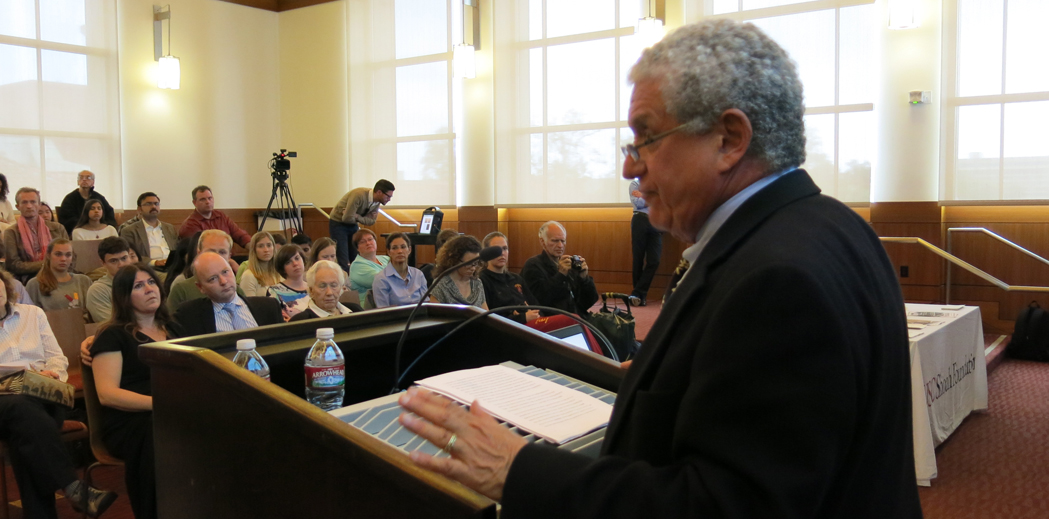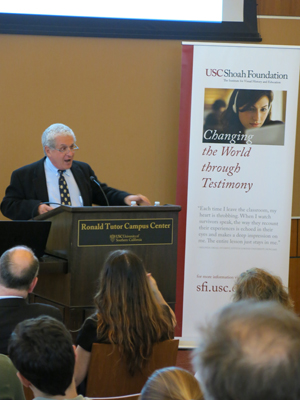Doug Greenberg Lecture Reveals Untold Story of the Holocaust in Wolyn

 In her testimony in the Visual History Archive, Holocaust survivor Bronia Hatfield cannot hide her anger. One of the worst slaughters of the Holocaust happened in her home of Wolyn and no one seems to know about it.
In her testimony in the Visual History Archive, Holocaust survivor Bronia Hatfield cannot hide her anger. One of the worst slaughters of the Holocaust happened in her home of Wolyn and no one seems to know about it.
“One and a half million people never made it to any camp,” Hatfield says. “They killed them right there and then.”
USC Shoah Foundation Senior Institute Fellow Doug Greenberg played this clip during his lecture Memories of the Forgotten Holocaust: The Jews of Wolyn, 1900-2000, Monday night in USC’s Ronald Tutor Campus Center. Hatfield’s impassioned cry captured the message of Greenberg’s lecture: The people of Wolyn were slaughtered years before the most recognizable events of the Holocaust even began, yet they have largely disappeared from public and scholarly memory.
Greenberg began the talk by explaining that his grandfather was from Wolyn, but he and Greenberg’s grandmother could never agree on what country Wolyn actually belonged to (throughout the 20th century it was alternately part of six countries including Poland, the Soviet Union and Ukraine).
Greenberg said that Jews in Wolyn were middle class, urban people, not peasants like the charachers in Fiddler on the Roof. He showed one photograph of young Wolynian men posing in front of an automobile that “could have been taken in Los Angeles,” Greenberg said.
In 1939, both the Soviet Union and Germany invaded Wolyn, but Germany withdrew under a non-aggression agreement. It remained under Stalin’s control until June of 1941, when Hitler broke the agreement and invaded again. Mass murder of Wolyn’s sizeable Jewish minority population began immediately, Greenberg said.
Over the next 18 months, Jews were taken by the thousands to mass graves in and around Wolyn and shot to death, or killed in their homes, or in front of their neighbors. In a cruel twist of fate, a large number of Jews from other parts of Europe who sought to go into hiding until the war was over had begun coming to Wolyn – thinking they’d be safer under Stalin than Hitler. But they, too, were quickly found and murdered along with the families who hid them.
Unlike the rest of Europe, in Wolyn, mass murder of Jews preceded ghettoization, Greenberg said.
“They were not taken to the Holocaust; the Holocaust came to them,” he said.
By January of 1942, the slaughter in Wolyn was over. To put this in perspective, Greenberg noted that at this time Auschwitz had not even been built and Anne Frank had not yet gone into hiding. For most Jews in Europe, the Holocaust was just beginning.
While a small number of Wolynian Jews managed to survive by hiding in the forest or miraculously escaping from mass shootings, by the end of the war 98.5 percent of Wolyn’s Jewish population was dead and most of its towns were destroyed.
Because so few survived to talk about what happened to them, the destruction of Wolyn has nearly been forgotten.
“The Nazis in Wolyn did what they intended,” Greenberg said. “They exterminated the Jews not only from life but from memory too.”
Today, not much has changed. “The only thing that makes Wolyn newsworthy is that it has been forgotten,” Greenberg said.
Greenberg said information about Wolyn is difficult to find in research conducted by even the most renowned authorities on the Holocaust – Yad Vashem and the United States Holocaust Memorial Museum. In fact, testimonies in the Visual History Archive have been the source of most of what Greenberg has learned about Wolyn, he said.
The details recounted by survivors in their testimonies offer the opportunity for people today to remember Wolyn, and the Holocaust, for what it was: not just genocide on a massive scale, but “a horrendous collection of many crimes, each awful in its own way, each a unique reminder of the human capacity for incomprehensible evil,” Greenberg said.